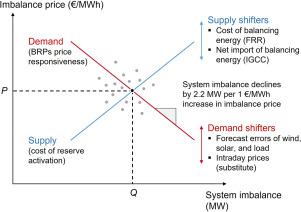Energy Economics ( IF 13.6 ) Pub Date : 2021-07-19 , DOI: 10.1016/j.eneco.2021.105455 Anselm Eicke 1 , Oliver Ruhnau 1 , Lion Hirth 1, 2

|
Frequency stability requires equalizing supply and demand for electricity at short time scales. Such electricity balancing is often understood as a sequential process in which random shocks, such as weather events, cause imbalances that system operators close by activating balancing reserves. By contrast, we study electricity balancing as a market where the equilibrium price (imbalance price) and quantity (system imbalance) are determined by supply and demand. System operators supply imbalance energy by activating reserves; market parties that, deliberately or not, deviate from schedules create a demand for imbalance energy. The incentives for deliberate strategic deviations emerge from wholesale market prices and the imbalance price. We empirically estimate the demand curve of imbalance energy, which describes how sensitive market parties are to imbalance prices. To overcome the classical endogeneity problem of price and quantity, we deploy instruments derived from a novel theoretical framework. Using data from Germany, we find a decline in the demand for imbalance energy by 2.2 MW for each increase in the imbalance price by EUR 1 per MWh. This significant price response is remarkable because the German regulator prohibits strategic deviations. We also estimate cross-market equilibriums between intraday and imbalance markets, finding that a shock to the imbalance price triggers a subsequent adjustment of the intraday price.
中文翻译:

作为市场均衡的电力平衡:基于仪器的不平衡能源供需估计
频率稳定性需要在短时间内平衡电力的供需。这种电力平衡通常被理解为一个连续过程,其中随机冲击(例如天气事件)会导致系统运营商通过激活平衡储备来关闭不平衡。相比之下,我们将电力平衡研究为一个市场,其中均衡价格(不平衡价格)和数量(系统不平衡)由供需决定。系统运营商通过激活储备供应不平衡能量;有意或无意偏离时间表的市场各方都会产生对不平衡能源的需求。故意战略偏差的动机来自批发市场价格和不平衡价格。我们凭经验估计不平衡能源的需求曲线,它描述了市场各方对不平衡价格的敏感程度。为了克服价格和数量的经典内生性问题,我们部署了衍生自新理论框架的工具。使用来自德国的数据,我们发现不平衡价格每增加 1 欧元/兆瓦时,对不平衡能源的需求就会下降 2.2 兆瓦。这种显着的价格反应非常引人注目,因为德国监管机构禁止战略偏差。我们还估计了盘中和失衡市场之间的跨市场均衡,发现对失衡价格的冲击会触发盘中价格的后续调整。我们发现,不平衡价格每增加 1 欧元/兆瓦时,对不平衡能源的需求就会下降 2.2 兆瓦。这种显着的价格反应非常引人注目,因为德国监管机构禁止战略偏差。我们还估计了盘中和失衡市场之间的跨市场均衡,发现对失衡价格的冲击会触发盘中价格的后续调整。我们发现,不平衡价格每增加 1 欧元/兆瓦时,对不平衡能源的需求就会下降 2.2 兆瓦。这种显着的价格反应非常引人注目,因为德国监管机构禁止战略偏差。我们还估计了盘中和失衡市场之间的跨市场均衡,发现对失衡价格的冲击会触发盘中价格的后续调整。









































 京公网安备 11010802027423号
京公网安备 11010802027423号